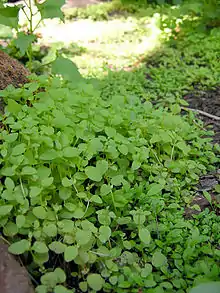Erythranthe gemmipara
Erythranthe gemmipara is a rare species of flowering plant in the family Phrymaceae, known by the common name Rocky Mountain monkeyflower. It is endemic to Colorado in the United States, where there are eight known occurrences.[1] It was formerly known as Mimulus gemmiparus.[2][3][4][5][6]
| Erythranthe gemmipara | |
|---|---|
 | |
| Scientific classification | |
| Kingdom: | Plantae |
| Clade: | Tracheophytes |
| Clade: | Angiosperms |
| Clade: | Eudicots |
| Clade: | Asterids |
| Order: | Lamiales |
| Family: | Phrymaceae |
| Genus: | Erythranthe |
| Species: | E. gemmipara |
| Binomial name | |
| Erythranthe gemmipara (W.A.Weber) G.L.Nesom & N.S.Fraga | |
This annual herb grows about 10 centimeters (3.9 inches) tall. Some of the leaves have propagules on their petioles called gemmae. When a leaf falls off the plant the gemma can generate a new plant; this is the mode of reproduction for this species, as flowers are rarely produced and they are sterile.[7] The gemmae are probably dispersed on water. The plants occur in colonies of mother and daughter plants.[1] When they do occur, the flowers are yellow with variable patterns of red spots and measure about half a centimeter long. While the flowers are rare in nature, the plants may produce many flowers when propagated in the greenhouse.[8]
This plant grows in subalpine climates in moist areas such as seeps in granite outcrops and overhangs and forest habitat near springs. It can often be found alongside other Erythranthe species,[1] such as Erythranthe floribunda, Erythranthe guttata, and Erythranthe rubella. The forests are dominated by spruce, fir, and aspen and other plants in the habitat may include Jamesia americana (fivepetal cliffbush), Dodecatheon spp. (shootingstar), Aquilegia saximontana (Rocky Mountain blue columbine), Epilobium spp. (fireweed), Salix spp. (willow), Campanula rotundifolia (bluebell bellflower), Artemisia ludoviciana (white sagebrush), Packera plattensis (prairie groundsel), Erigeron subtrinervis (threenerve fleabane), Rhodiola integrifolia (ledge stonecrop), Oreochrysum parryi (Parry's goldenrod), Brickellia microphylla (littleleaf brickellbush), Amelanchier utahensis (Utah serviceberry), and Montia chamissoi (water minerslettuce).[8] Threats to this species include recreational activities such as hiking and horseback riding.[1]
References
- Mimulus gemmiparus. The Nature Conservancy. Retrieved 11-04-2011.
- Giblin, David, ed. (2015). "Erythranthe guttata". WTU Herbarium Image Collection. Burke Museum, University of Washington. Retrieved 2015-03-31.
- Barker, W.R.; Nesom, G.L.; Beardsley, P.M.; Fraga, N.S. (2012), "A taxonomic conspectus of Phrymaceae: A narrowed circumscriptions for Mimulus, new and resurrected genera, and new names and combinations" (PDF), Phytoneuron, 2012–39: 1–60
- Beardsley, P. M.; Yen, Alan; Olmstead, R. G. (2003). "AFLP Phylogeny of Mimulus Section Erythranthe and the Evolution of Hummingbird Pollination". Evolution. 57 (6): 1397–1410. doi:10.1111/j.0014-3820.2003.tb00347.x. JSTOR 3448862. PMID 12894947. S2CID 14119163.
- Beardsley, P. M.; Olmstead, R. G. (2002). "Redefining Phrymaceae: the placement of Mimulus, tribe Mimuleae, and Phryma". American Journal of Botany. 89 (7): 1093–1102. doi:10.3732/ajb.89.7.1093. JSTOR 4122195. PMID 21665709.
- Beardsley, P. M.; Schoenig, Steve E.; Whittall, Justen B.; Olmstead, Richard G. (2004). "Patterns of Evolution in Western North American Mimulus (Phrymaceae)". American Journal of Botany. 91 (3): 474–4890. doi:10.3732/ajb.91.3.474. JSTOR 4123743. PMID 21653403.
- Moody, A.; et al. (1999). "Developmental analysis of the evolutionary origin of vegetative propagules in Mimulus gemmiparus (Scrophulariaceae)". Am J Bot. 86 (11): 1512–22. doi:10.2307/2656789. JSTOR 2656789. PMID 10562243.
- Beatty, B.L., W.F. Jennings, and R.C. Rawlinson (2003, November 21). Mimulus gemmiparus W.A. Weber (Rocky Mountain monkeyflower): A technical conservation assessment. [Online]. USDA Forest Service, Rocky Mountain Region. Retrieved 11-04-2011.
